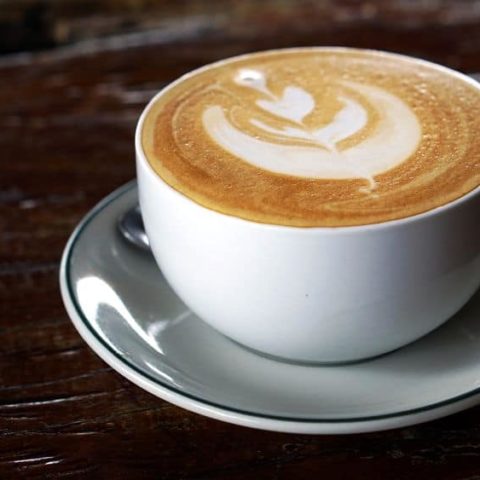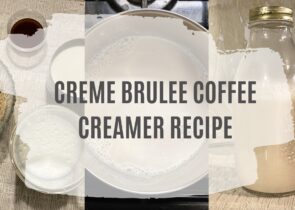The Latte. The Classic. The King of coffee. Loved by many, yet truly known by few.
When people think of coffee, this drink is one of the first things that comes to mind. Thick, creamy milk and rich, robust espresso come together in a delicious combination that makes every coffee lover’s mouth water.
What Is A Latte?
A latte is a classic coffee that’s constructed with the two pillar ingredients: espresso and steamed milk. The word “latte” comes from the Italian word “caffè e latte” (other variants are “caffeelatte” and “caffellatte”), which simply means “coffee & milk.”
The standard combination for a latte is 1/3 espresso, 2/3 steamed milk, and a small, thin layer of microfoam on the surface. With this ratio, baristas can easily adjust the size of the latte when you order it, though the traditional size of the latte ranges between 10-12 ounces.
Why Fall In Love With The Latte?
However, one great factor about lattes is that they are highly customizable. They can be easily decorated with flavorings such as mocha, caramel, vanilla, or other syrups, as well as different milk types like soy, almond, coconut, or oat. Furthermore, you can also replace the coffee entirely by supplementing tea instead! Some of the more popular tea supplements include masala chai, matcha, rooibos, and more.
The great thing about the latte is that it’s a great espresso beverage for those who don’t want anything super strong. Though there’s espresso, which is very robust and strong in caffeine content, the proportion of milk will heavily dilute the severity of the caffeine in the coffee.
Latte Art: Making A Masterpiece?
Many baristas tend to enjoy brewing lattes due to the distinguished practice of creating latte art. This art form consists of methodically pouring steamed milk into espresso to create complex designs such as leaves, flowers, heart-shapes, and more. There’s even an international competition for latte art that occurs annually, and it’s an event that’s held in high regard in the coffee community.
The Legend Of The Latte
So, where did this classic coffee beverage come from? People have been enjoying the coffee + milk combination since the 1600s, and as time has passed, the name and reference of the drink combination has evolved. In the late 1700s, coffee houses in Austria began offering a beverage named the Kapuziner, which consisted of coffee with cream, sugar, and spices. This was the beginning of the classic Italian cappuccino.
The term “caffè e latte” first appeared in the English language in 1867 by William Dean Howells in an essay titled “Italian Journeys.” Though coffee was often consumed as part of breakfast in European households for years, the latte is an American invention. Throughout history, even throughout WWII, the “latte” could not be found on Italian or French cafe menus.
The primary reason for the adaption of the word “latte” is because it’s simple shorthand slang for “caffe latte,” AKA coffee and milk. Over time, the shorthand term “latte” began to refer to an espresso beverage that mostly consists of milk. The rest is history!
Drink Comparisons
The latte is already super flexible in ingredients, but it can also easily be confused with other common espresso beverages. Here are some of the most common coffee beverages that can easily be confused with the lovable latte.
Café Au Lait
The ancestor of the latte, the café au lait is similar to the makeup of the latte as far as the pairing of coffee and milk. However, the primary difference between these two coffee beverages is the kind of coffee used in them. Since drip coffee uses a higher proportion of water to coffee when brewing, drip coffee does have a decent amount of caffeine, though it isn’t as severe as the amount of caffeine in espresso.
As far as makeup is concerned, the café au lait usually has about 1/2 drip coffee to 1/2 steamed milk. Unlike the latte, the café au lait uses regular drip coffee instead of shots of espresso. In contrast to the café au lait, the latte is made up of about 1/3 espresso and 2/3 milk.
Latte Macchiato
The cooler cousin of the latte and the macchiato, the latte macchiato is a blend between these two drinks. When making a latte, the espresso is usually poured into the glass first, and the steamed milk is poured in afterward. However, the latte macchiato is the reverse of this process. The milk is steamed to a velvety microfoam consistency, which is then poured into a cup. After the milk is poured, then a half-shot of espresso is gently poured on top of it. This creates a layered drink with a spot of espresso on it, called a “macchia.”
The primary difference between the latte and the latte macchiato is the order of ingredients, as well as the amount of espresso. As a result of the smaller amount of espresso, the latte macchiato is significantly weaker in caffeine content than the latte.
Cappuccino
Though both drinks use 1-2 shots of espresso, there are many differences between these two drinks, from the volume, to the proportion of ingredients, to the potency. Espresso with steamed milk topped with a deep layer of fluffy, frothy foam. The cappuccino has much more milk foam than the latte does, though both drinks have steamed milk in them.
The cappuccino is a smaller drink, about 6 ounces total with 3 ounces of espresso and 3 ounces of milk, as well as a decent amount of milk foam. The surplus of milk foam is a huge reason why many coffee lovers prefer the cappuccino. Due to the proportion of the ingredients, the cappuccino is more caffeinated than the latte because of the smaller amount of milk.
How To Make A Latte
The latte is one of the most common coffee drinks in the coffee community today, and any professional barista in any coffee shop should know how to brew it. If you have an espresso machine available at home, all you need is some milk to begin brewing a latte in the comfort of your own home! You can watch our handy-dandy video tutorial below, or read our step-by-step instructions on latte brewing below.
To begin brewing your latte, you’ll need the following ingredients:
- Espresso machine
- Milk frother
- Milk pitcher
- Optional coffee grinder
- 7-9 ounces of milk of your preference
- 16.5 grams of ground espresso beans
- A 10-12 ounce sized latte cup
Think Normal Lattes Are Lame?
Don’t like the usual latte? The great news is that since the latte is so flexible and adaptable, you can customize ingredients to your liking.
What About Tea?
Not a fan of espresso? Don’t let that stop you! You can also brew your latte with a tea of your choice! Instead of using espresso, you can easily supplement a tea of your choice. All you need to do is steep the same amount of tea to adequately supplement the espresso and then pour in your steamed milk. Voila!
Make It Iced
Want something to cool you down on a hot summer morning? You can make an iced latte instead! Making an iced latte is similar to the process of making a hot latte. You’ll still extract your espresso (or tea) as usual, but instead of steaming your milk, you’ll pour in cold milk into your latte instead. And to keep it cold, all you have to do is plop a few ice cubes in your cup so you can sip on your iced latte for longer!
Wrapping Up
There you have it! Now you can make a latte any way, anywhere, anytime! If you’re new to coffee and are wanting to experiment with or grow your palette, the latte is a simple beginner’s method into the world of coffee brewing. So, enjoy making your lattes, and as always:
Happy caffeinating!

How To Make A Latte
One of the most well-known drinks in the world today, a latte is a delicious, creamy, espresso-based coffee drink. It's rich in flavor and is soothing to drink at any time of day. Now you can make one in the comfort of your own kitchen!
Ingredients
- 7-9 oz of milk of your preference
- 16.5 grams of ground espresso beans
- A 10-12 oz latte cup
Instructions
1. Grind 16.5 grams of espresso coffee.
2. Extract espresso with espresso machine into the 10-12 ounce cup.
3. Pour 7-9 ounces milk into milk pitcher. Steam to 160° F.
4. When espresso completes brewing, pour steamed milk at an angle about 3-4 inches above the cup.
5. Enjoy!
Nutrition Information:
Yield: 1 Serving Size: 12 ozAmount Per Serving: Calories: 200Total Fat: 7g







